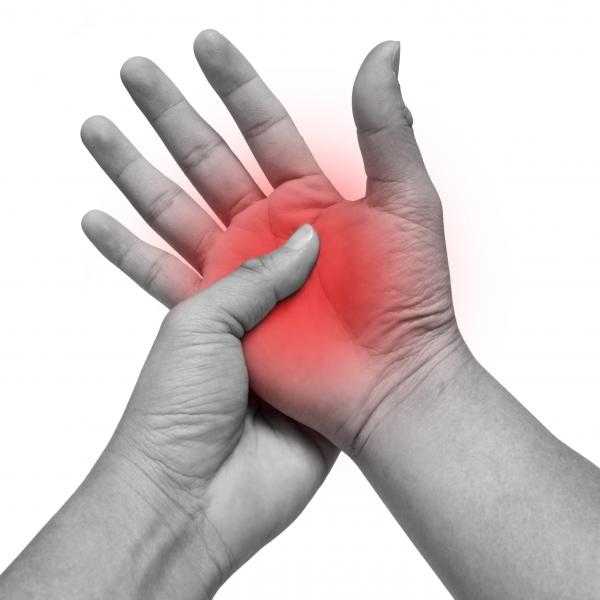
Did you know that the bones in our hands make up about 26% of the bones in our entire body?! Each of our hands are made up of 27 bones and 3 nerves. With all of those bones and all of the usage our hands get, it's no wonder why hand pain and injury can make even the simplest tasks seem so difficult. Read on to learn more about common causes, conditions, injury prevention and rehabilitation for the hand.
Common Causes
Hand pain can be caused by overuse and sudden (acute) injury.
- Overuse – Occurs when too much stress is placed on a joint or tissue by "overdoing" or doing an activity repetitively.
- Sudden (Acute) Injury – Occurs from a direct blow, penetrating hand injury or an accidental fall. Twisting, jamming and bending a limb in an unsual was can also cause an injury. Some causes of acute injuries include:
- Sports or recreational activities
- Work-related tasks
- Work or projects around the home
Common Conditions
Hand pain can be caused by any one of these common conditions:
- Carpal Tunnel Syndrome – The carpal tunnel is a narrow passageway located on the palm side of your wrist. Carpal tunnel syndrome is caused by a pinched nerve in the wrist, causing numbness, tingling and pain around the fingers. These sensations are often more pronounced at night and can awaken people from sleep. Chronic carpal tunnel syndrome can also lead to atrophy of the hand muscles and reduced in grip strength.
- De Quervain's Tenosynovitis – This condition affects the tendons on the thumb side of your wrist, making it painful to turn your wrist, grasp objects or make a fist. The two tendons in your wrist and lower thumb normally glide smoothly through the small tunnel that connects them to the base of the thumb. Overuse from repetitive motions (gripping, grasping, clenching, pinching, wringing) may irritate the sheath around the two tendons, causing thickening and swelling that restricts their movement.
- Trigger Finger – Trigger finger, also known as stenosing tenosynovitis, is a condition in which one of your fingers gets stuck in a bent position. Your finger may straighten with a snap — like a trigger being pulled and released. Trigger finger occurs when inflammation narrows the space within the sheath that surrounds the tendon in the affected finger. It more commonly affects your thumb or your middle or ring finger, and in severe cases, your finger may become locked in a bent position.
- Arthritis – Arthritis is inflammation of one or more of your joints. There are more than 100 different forms, but the most common types of arthritis are osteoarthritis, which is mainly caused by wear and tear of the joints; and rheumatoid arthritis, which is when damage occurs to the joint lining and cartilage, eventually resulting in erosion of two opposing bones.
- Finger Dislocation – Dislocations are joint injuries that force the ends of your bones out of position. The cause is often a fall or a blow, sometimes from playing a contact sport such as basketball. Finger dislocation can occur in any of the joints of any finger, but it occurs most often in the middle knuckle of the little (pinky), ring, middle, or index finger.
Injury Prevention
Kathy VanLeeuwen, clinic director at our Geneva, IL clinic, gives us some tips to help prevent and rehabilitate hand injuries:
- Good Posture – Healthy hands begin with healthy behaviors! Posture impacts your hands and arms directly. If you are slouching over your keyboard, your elbows/wrists leaning on your desk, your poor wrists and hands have to do all of the work. If you sit up with hands poised over the keyboard, shoulders back and relaxed, your hands float over the keys without any compressive forces on your carpal tunnel! It also unloads your small wrist muscles (tennis elbow, anyone?) and allows your larger, upper arm muscles to do more work.
- Stretch – Don’t ignore your small muscles when doing your daily stretches! Loosening shoulders, wrists and hands increases your comfort level as well as prolongs endurance for home and work activities. When you are stretching your hamstrings and quads for your run, add in your arms, too.
- Micro Rest – Sitting at a screen all day? Micro rests can provide needed recuperation for tissues and improve endurance, as well as decrease pain from arthritis, etc. Every 1-2 hours, relax your arms in your lap with your palms up for 10-20 seconds, then return to work. Listen to your body, it will let you know when it needs a break.
Rehabilitation
If you have pain in your hand that isn't going away, rehabilitation is a great step to take to improve your functionality. Hand rehabilitation may include:
- Stretching, Positioning, Protection – For non-traumatic hand/wrist injuries, stretching, positioning and joint protection are important parts of the recovery process.
- Patience – It takes intentional focus to make changes in a body part we use so automatically. Be patient with yourself!
- Strengthening – Strengthening hand muscles is different than many other body parts. The thumb, for example, has multiple planes of motion which can contribute to arthritis, deformity and pain. Specific strengthening with the understanding of the special architecture/muscle structure plays a big role in success of treatment.
When weighing your treatment options for hand pain and injuries, consider physical therapy. Physical therapy offers a wide variety of treatment options including strengthening, stretching, and sustainable home exercise programs. Stop in or call any ATI location for a complimentary injury screen or to learn more about how physical therapy can help you overcome your hand pain. Click here to schedule a complimentary injury screen.
Lending you a helping hand!
